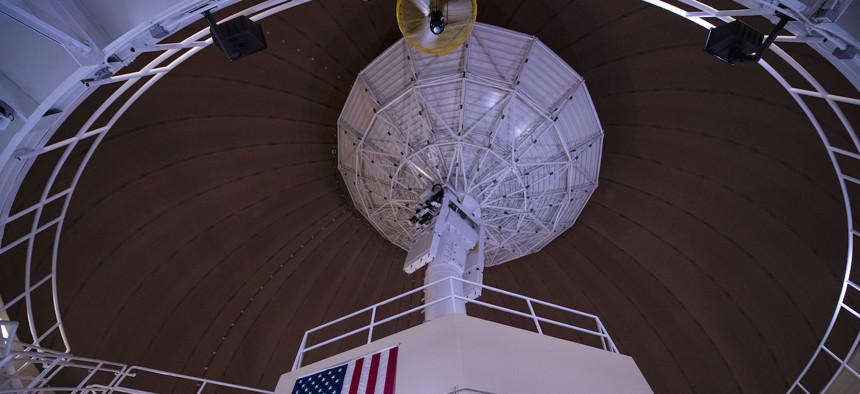
A radome receives data from satellites at Kaena Point Space Force Station, Hawaii, Sept. 14, 2022. U.S. Air Force / Senior Airman Brooke Wise
Satellite Ground Stations Are Vulnerable, US Warns
The Space Development Agency is beefing up satellite constellations—but keeping an eye on terrestrial attacks.
As the Space Development Agency moves to put larger satellite constellations into multiple orbits, it has become increasingly concerned with keeping the ground stations that control those satellites safe.
“Common mode failures [such as cyber attacks] can take out all your satellites from the ground systems, then you can't proliferate your way out of that—so that's a major concern. We have a lot of protections in place, and that's something that we put a lot of resources on to make sure that we're hardened against cyber threats,” Derek Tournear, SDA’s director, said Monday at the Navy League's annual Sea-Air-Space conference.
The agency, which fully transitioned to the Space Force in October, wants hundreds of satellites in different orbits working together to build a proliferated space architecture. On Sunday, it launched its “Tranche 0” satellites—sending off 10 satellites from SpaceX’s Falcon 9 reusable, two-stage rocket. The satellites were launched from Vandenberg Space Force Base, California to low-Earth orbit, or LEO. The launch was originally scheduled for March 30, but was delayed a few days “to investigate technical issues with the launch vehicle,” according to the Pentagon.
Tranche 0 is planned as the “warfighter immersion tranche,” to test the “feasibility” of SDA concepts like low latency data connectivity, beyond line of sight targeting, and missile warning/missile tracking.
The rest of the planned 28 satellites in Tranche 0 will be launched in June, Tournear said, and the agency will begin launching Tranche 1, the “first initial warfighting capability,” in 18 months. By 2025, “we’ll be able to have the ability to take the fight through a regional theater and bring these technologies to bear,” Tournear said.
“Our satellites are more affordable than missiles that you need to shoot them down. So we've kind of taken that off the table and made it to where it's really difficult to shoot those satellites, just by virtue of proliferation,” Tournear said.
In addition to cyber attacks, a supply chain delay could also cause a common mode failure, Tournear said. SDA wants satellites built quickly, he said, but needs a robust industrial base to supply the components.
The Pentagon is also preparing for conflict in the radio-frequency spectrum, or RF spectrum, and the Navy is “leading the way” on anti-jamming systems to work in those environments, Tournear said.
“It's not a peaceful domain—and RF spectrum combat is something you're going to hear a lot more about,” he said.
Tournear said SDA is prioritizing speed and aims to get new capabilities fielded in space every two years, even if it’s not the “most exquisite capability.”
“We’ll put schedule above cost and we'll put a cost above performance to make sure we hit those to two-year timelines. We're not going to get every capability out in the next two years, but we will get more and more capabilities as we continue to fill this out, which means the warfighter will get the capabilities they need soon,” Tournear said.



